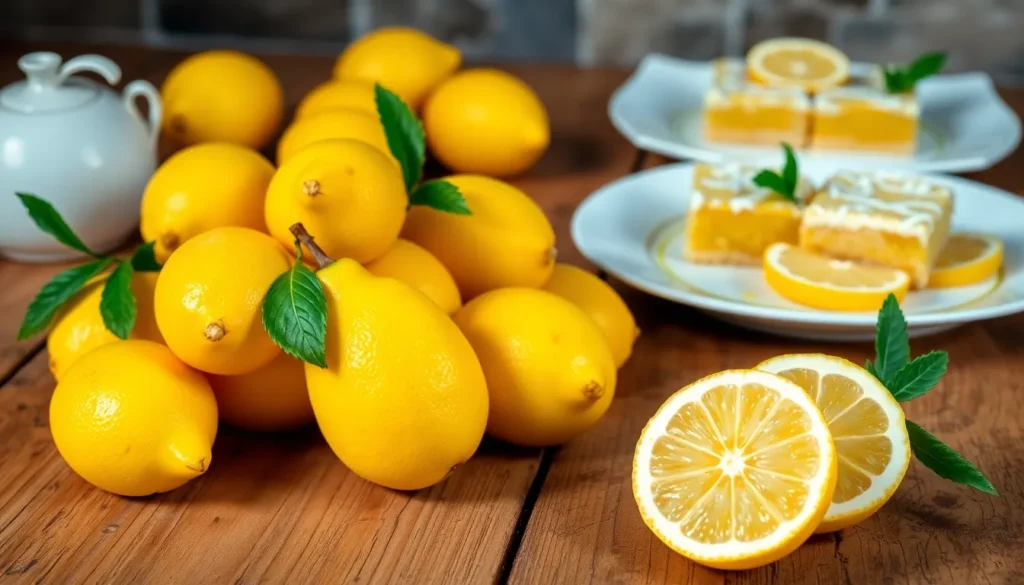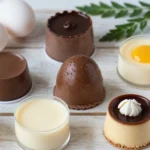Meyer lemons bring a unique sweetness to our kitchens that regular lemons simply can’t match. These golden gems offer a perfect balance of tartness and floral notes that’ll transform your everyday dishes into something extraordinary. We’ve discovered that their thin skin and juice-packed interior make them ideal for both sweet and savory applications.
Unlike traditional Eureka lemons, Meyer lemons pack less acidity and more natural sweetness, making them perfect for recipes where you want bright citrus flavor without overwhelming sourness. They’re actually a cross between a lemon and a mandarin orange, which explains their distinctive taste profile that’s captivated chefs and home cooks alike.
We’re excited to share our collection of Meyer lemon recipes that showcase this incredible fruit’s versatility. From zesty desserts to vibrant marinades, these recipes will help you make the most of Meyer lemon season and understand why they’ve become such a coveted ingredient in kitchens everywhere.
What Makes Meyer Lemons Special
Meyer lemons stand apart from regular lemons in remarkable ways that transform every dish they touch. These golden gems offer a distinctly sweeter flavor profile with significantly less acidity than traditional Eureka lemons. We find their taste combines the bright citrus notes of lemons with subtle floral undertones and a hint of mandarin sweetness.
The secret behind their unique characteristics lies in their botanical heritage. Meyer lemons are actually a natural hybrid between a lemon and a mandarin orange. This crossbreeding creates their signature thin skin that’s more orange than yellow and their incredibly fragrant oils. When we zest Meyer lemons the aromatic oils release an almost perfumed scent that regular lemons simply cannot match.
Their lower acidity makes them incredibly versatile in both sweet and savory applications. Traditional lemons can overpower delicate flavors but Meyer lemons enhance dishes without overwhelming them. We appreciate how they brighten seafood marinades without making them too tart and how they create perfectly balanced desserts without requiring excessive sugar to counteract sourness.
The texture of Meyer lemons also sets them apart. Their thinner skin means more juice per fruit and less bitter pith. This characteristic allows us to use both the zest and juice more liberally in recipes. The skin itself is so tender that many cooks candy it whole or use it as an edible garnish.
Seasonality plays a crucial role in Meyer lemon quality. These specialty citrus fruits peak from December through May with the best specimens appearing in winter months. During peak season their juice content reaches maximum levels while their natural oils concentrate for the most intense flavor impact.
Meyer lemons contain higher sugar content than regular lemons which explains their naturally sweet taste. This sweetness paired with their complex flavor profile makes them ideal for applications where we want citrus brightness without harsh tartness. Their balanced acidity level hovers around 6% compared to regular lemons at 8% creating a gentler citrus experience.
Essential Equipment for Meyer Lemon Cooking
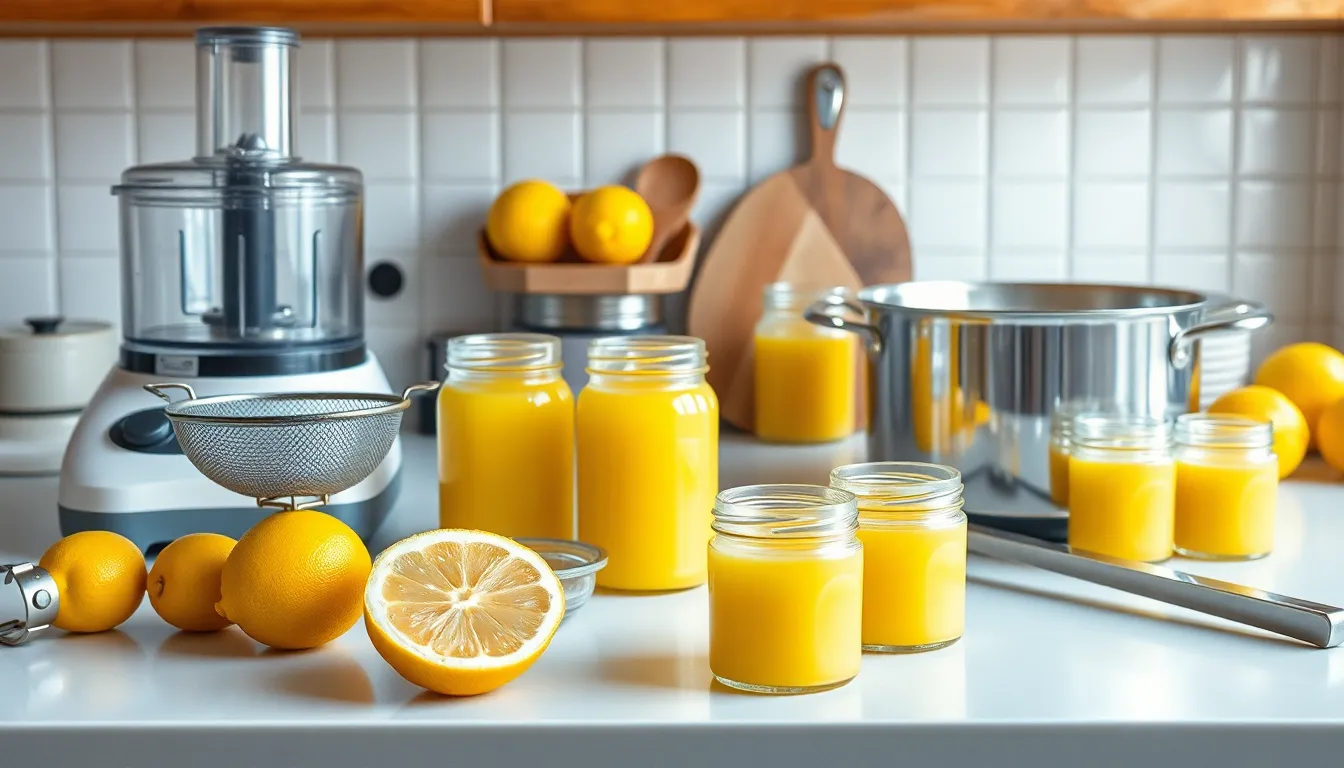
Working with Meyer lemons requires exact tools to maximize their unique sweet and aromatic qualities. We’ve found that having the right equipment makes all the difference when preparing these delicate citrus gems for various recipes.
A food processor serves as our primary tool for zesting and grinding Meyer lemons effectively. This powerful appliance helps us extract maximum flavor from the thin, fragrant skins without damaging the delicate oils. The food processor also allows us to create fine zest that distributes evenly throughout our recipes.
Our fine mesh strainer becomes essential when working with Meyer lemon juice. Since these lemons contain seeds that can add unwanted bitterness, we always strain the juice to ensure smooth textures in our curds and marinades. The fine mesh catches even the smallest seed fragments while allowing the precious juice to flow through.
Temperature control proves critical when making Meyer lemon curds and preserves, which is why we rely on a thermometer. Meyer lemons contain different sugar levels than regular lemons, so monitoring cooking temperatures ensures our curds reach the perfect consistency without curdling.
A heavy-bottomed saucepan provides even heat distribution when cooking Meyer lemon curds and marmalades. The consistent temperature prevents hot spots that could scorch the delicate sugars in Meyer lemons, allowing us to achieve silky smooth textures every time.
Glass jars complete our essential equipment list for storing homemade Meyer lemon preserves and curds. These containers preserve the bright flavors and allow us to see the beautiful golden color of our finished products.
| Equipment | Primary Use | Key Benefit |
|---|---|---|
| Food Processor | Zesting and grinding | Maximum flavor extraction |
| Fine Mesh Strainer | Seed removal | Smooth textures |
| Thermometer | Temperature monitoring | Perfect consistency |
| Saucepan | Cooking curds/marmalades | Even heat distribution |
| Glass Jars | Storage | Flavor preservation |
Sweet Meyer Lemon Recipes
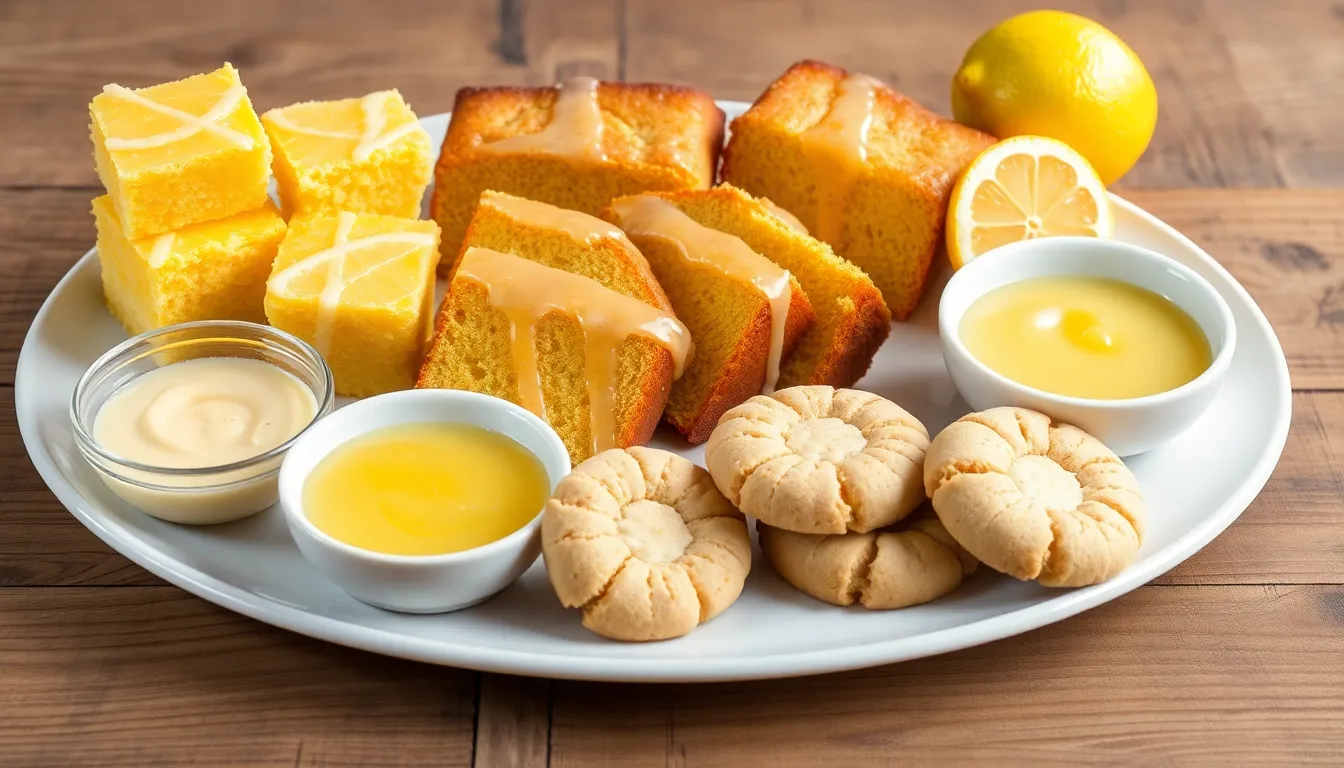
Sweet Meyer lemon recipes showcase the fruit’s naturally balanced flavor profile and reduced acidity. These desserts highlight the delicate floral notes that make Meyer lemons perfect for elegant baked goods.
Meyer Lemon Bars
We create these vibrant bars using a classic shortbread crust topped with tangy Meyer lemon filling. The combination delivers a unique floral twist that sets them apart from traditional lemon bars. Our recipe balances the Meyer lemon’s natural sweetness with just enough tartness to create the perfect dessert square.
Start by preparing the shortbread base with butter, flour, and powdered sugar. Press the mixture into your prepared pan and prebake until lightly golden. Meanwhile, whisk together Meyer lemon juice, zest, eggs, and sugar for the filling. Pour this bright mixture over the warm crust and bake until the center sets but still has a slight jiggle.
The finished bars offer vibrant lemon flavor with hints of sweetness that make them irresistible. Dust with powdered sugar before serving to enhance their elegant appearance.
Meyer Lemon Pound Cake
This dense, moist cake showcases Meyer lemons’ subtle sweetness through every bite. We begin by creaming butter and sugar until light and fluffy, then incorporate eggs one at a time. Fresh Meyer lemon zest and juice infuse the batter with bright citrus notes without overwhelming tartness.
Our technique involves alternating dry ingredients with the wet mixture to maintain the cake’s signature dense texture. The Meyer lemon’s lower acidity allows us to use more juice without affecting the cake’s structure. Bake in a prepared bundt or loaf pan until a toothpick inserted in the center comes out clean.
Finish with a simple glaze made from powdered sugar and Meyer lemon juice. The glaze soaks into the warm cake, creating layers of lemon flavor throughout each slice.
Meyer Lemon Curd
We transform Meyer lemons into this tangy, creamy spread that captures their essence perfectly. The process combines Meyer lemon juice, sugar, eggs, and butter through careful temperature control. Unlike traditional lemon curd, our Meyer lemon version offers sweeter, less acidic taste due to the fruit’s unique characteristics.
Begin by whisking egg yolks and sugar in a heavy-bottomed saucepan. Add fresh Meyer lemon juice and cook over medium-low heat, stirring constantly until the mixture coats the back of a spoon. Remove from heat and whisk in cold butter pieces until smooth and glossy.
Strain the finished curd through a fine mesh strainer to ensure silky texture. This versatile spread works beautifully as a cake filling, scone topping, or standalone dessert served with fresh berries.
Meyer Lemon Cookies
Our Meyer lemon cookies incorporate both zest and juice to maximize the fruit’s bright, citrusy flavor. We create various styles including sugar cookies and shortbread, each highlighting different aspects of Meyer lemons’ complex taste profile. The cookies’ dough benefits from the Meyer lemon’s natural sweetness and floral undertones.
For sugar cookies, we cream butter and sugar before adding Meyer lemon zest and juice to the mixture. The dough requires chilling to maintain its shape during baking. Roll portions into balls and coat with sugar before baking until edges are lightly golden.
Shortbread variations call for a simpler approach with butter, flour, and Meyer lemon elements combined into a tender dough. Cut into shapes and bake until just set. Finish either style with a bright Meyer lemon glaze or simple dusting of powdered sugar to enhance their citrus appeal.
Savory Meyer Lemon Recipes
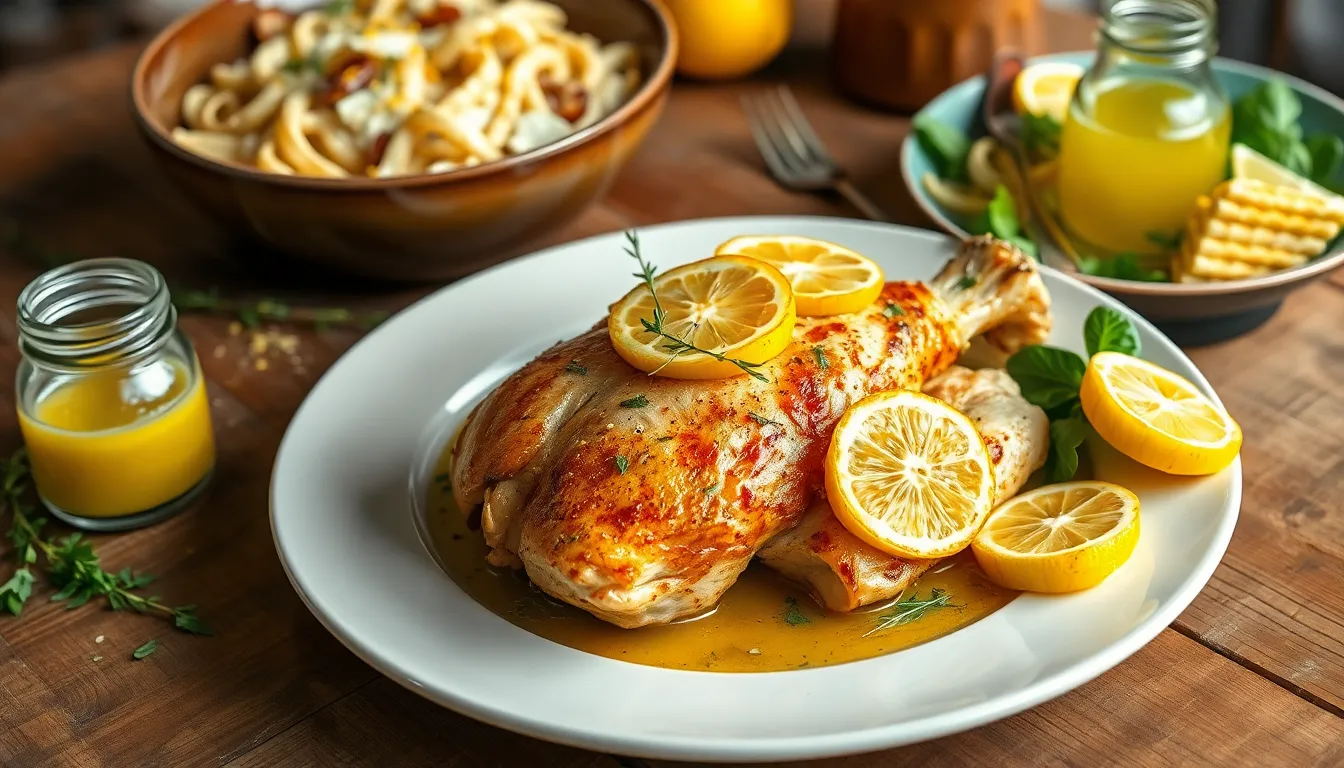
While Meyer lemons excel in sweet applications, their balanced acidity and subtle floral notes make them exceptional in savory dishes. We’ll explore how these golden citrus gems can transform your everyday meals into restaurant-quality experiences.
Meyer Lemon Roasted Chicken
Our Meyer lemon roasted chicken brings together tender meat with the bright complexity of these special citrus fruits. We start by creating a marinade with fresh Meyer lemon juice, zest, minced garlic, and aromatic herbs that penetrate deep into the chicken for maximum flavor.
The key technique involves roasting whole Meyer lemons alongside shallots until they break down into a syrupy, caramelized condiment. These roasted lemons develop rich, concentrated flavors that complement the chicken beautifully. We recommend placing the seasoned chicken over a bed of rice in a single pan, allowing the Meyer lemon juices to infuse the grains as everything cooks together.
This one-pan Meyer lemon chicken and rice dish eliminates cleanup while delivering complex flavors. The naturally lower acidity of Meyer lemons prevents the marinade from becoming overpowering, instead creating a harmonious balance that enhances the chicken’s natural taste.
Meyer Lemon Pasta
Traditional lemon pasta recipes like Spaghetti al Limone transform completely when we substitute Meyer lemons for regular varieties. The sweeter profile and reduced acidity create a more balanced sauce that won’t overwhelm delicate pasta flavors.
We prepare our Meyer lemon pasta by combining fresh juice with good olive oil, creating an emulsion that coats each strand perfectly. The naturally higher sugar content in Meyer lemons helps the sauce adhere better to the pasta without requiring excessive amounts of starchy pasta water.
Fresh Meyer lemon zest adds aromatic oils that brighten the entire dish. We recommend adding the zest at the end of cooking to preserve its vibrant flavor and prevent bitterness from overcooking.
Meyer Lemon Vinaigrette
Our basic Meyer lemon vinaigrette showcases how these citrus gems excel in simple preparations. We combine fresh Meyer lemon juice with premium olive oil, Dijon mustard, and a pinch of salt to create a versatile dressing.
The naturally balanced acidity of Meyer lemons means we can use more citrus juice without creating an overly tart vinaigrette. This makes our dressing perfect for delicate greens that might be overwhelmed by traditional lemon-based dressings.
We use this vinaigrette on mixed salads, grilled vegetables, and as a finishing sauce for grilled meats. The floral notes in Meyer lemons add complexity that elevates simple ingredients into sophisticated dishes.
Meyer Lemon Beverage Recipes
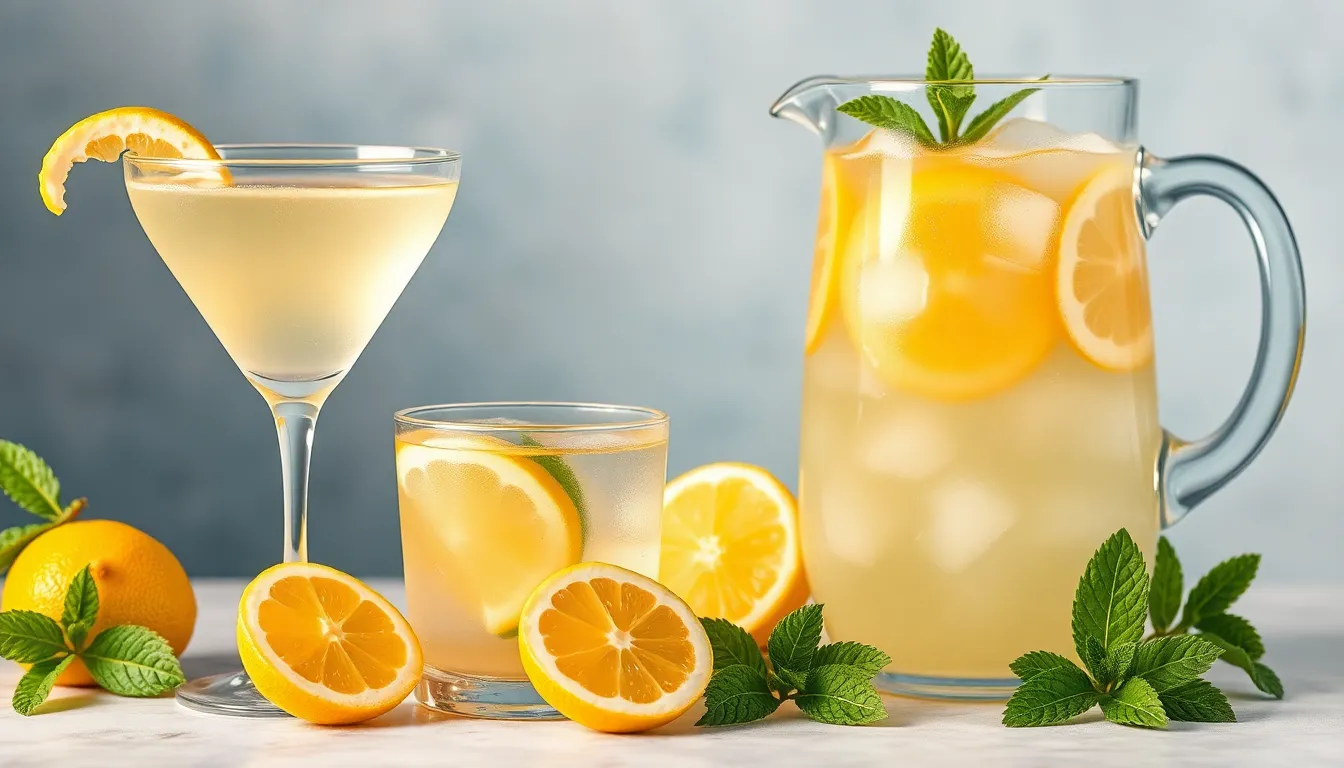
Meyer lemons shine brilliantly in beverages where their naturally sweet and floral qualities can transform ordinary drinks into extraordinary refreshments. These golden citrus gems create sophisticated cocktails and refreshing non-alcoholic beverages that capture their unique essence.
Meyer Lemon Cocktails
Meyer Lemon Martini
We love how this sophisticated cocktail highlights the citrusy complexity of Meyer lemons while maintaining elegant simplicity.
Ingredients:
- 2 oz vodka
- 1 oz fresh Meyer lemon juice
- 1/2 oz simple syrup
- Meyer lemon twist for garnish
- Ice
Instructions:
- Fill cocktail shaker with ice
- Add vodka, Meyer lemon juice, and simple syrup
- Shake vigorously for 15 seconds
- Double strain into chilled martini glass
- Express oils from Meyer lemon twist over drink
- Drop twist into glass and serve immediately
The Meyer lemon’s lower acidity creates a smoother martini that requires less sweetener than traditional lemon versions. This cocktail showcases the fruit’s natural balance between bright citrus and subtle floral notes.
Meyer Lemon Tea
We find Meyer lemon tea offers a gentler citrus infusion compared to regular lemon varieties. The fruit’s natural sweetness complements both black and herbal teas without overwhelming delicate flavors.
Hot Meyer Lemon Tea:
- 1 cup hot water
- 1 tea bag (black or herbal)
- 2-3 thin Meyer lemon slices
- Honey to taste (optional)
Instructions:
- Steep tea bag in hot water for 3-5 minutes
- Remove tea bag and add Meyer lemon slices
- Let slices infuse for 2-3 minutes
- Add honey if desired
- Remove lemon slices before drinking
Iced Meyer Lemon Tea:
Follow the same process but allow tea to cool completely before serving over ice. The Meyer lemon’s floral undertones create a more complex flavor profile that pairs beautifully with green or white teas.
Fresh Meyer Lemonade
Our Meyer lemonade recipe takes advantage of the fruit’s naturally sweet profile to create a less tart alternative to traditional lemonade.
Ingredients:
- 2-3 Meyer lemons
- 1 cup sugar
- 4 cups water
- Ice cubes
- Fresh mint sprigs (optional)
Instructions:
- Roll Meyer lemons on counter while pressing firmly to release juices
- Cut lemons in half and juice thoroughly
- Strain juice to remove seeds and pulp
- Combine Meyer lemon juice with sugar in large pitcher
- Stir vigorously until sugar completely dissolves
- Add water and mix well
- Taste and adjust sweetness if needed
- Serve over ice with fresh mint garnish
| Meyer Lemon vs Regular Lemon Comparison | |
|---|---|
| Sugar Content | Meyer lemons contain 30% more natural sugars |
| Acidity Level | 25% lower acid content than Eureka lemons |
| Juice Yield | Higher juice content due to thinner skin |
This lemonade offers a sweeter and more aromatic drinking experience thanks to the Meyer lemon’s unique flavor profile. The reduced acidity means we can use less sugar while still achieving perfect balance between sweet and tart flavors.
Ingredients for Basic Meyer Lemon Recipes
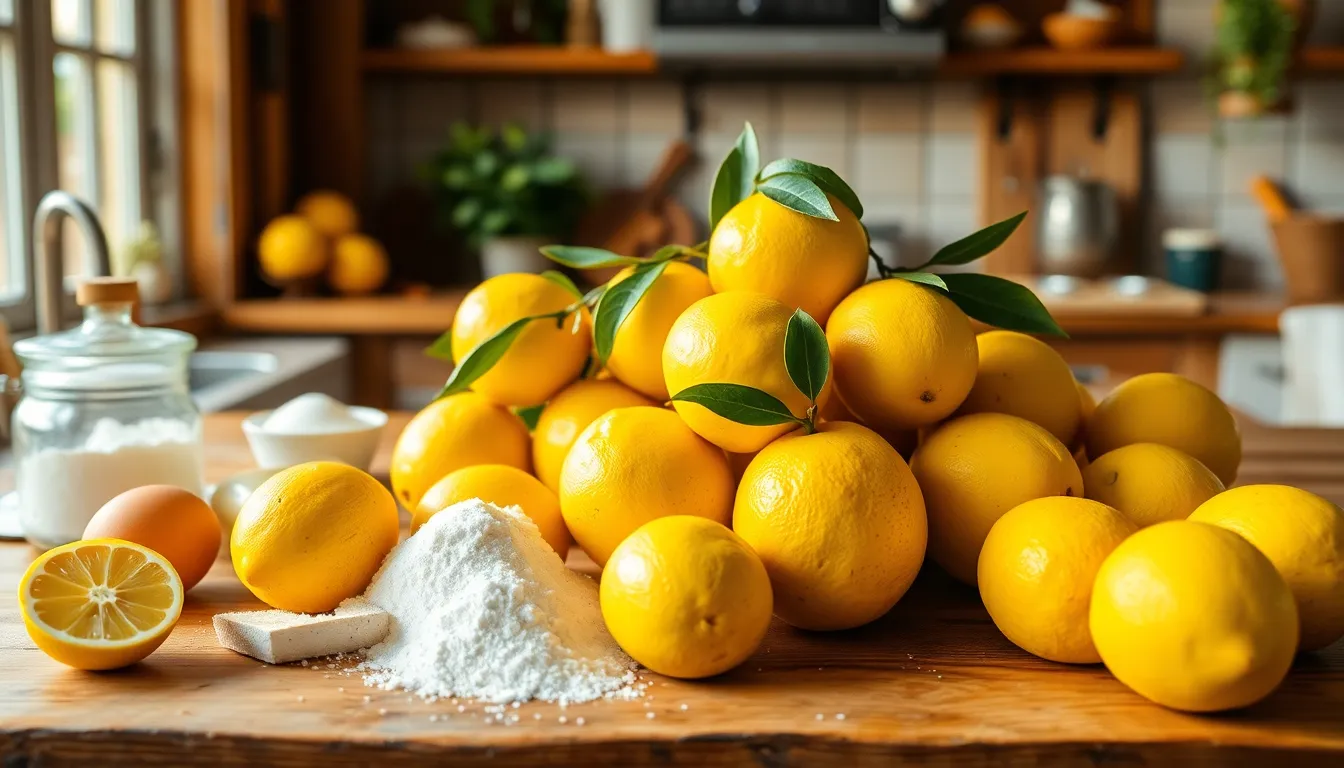
Building upon the unique qualities we’ve explored, we’ll now focus on the essential ingredients needed for three fundamental Meyer lemon recipes. These foundational recipes serve as building blocks for countless variations and showcase the fruit’s versatility in both sweet and savory applications.
Meyer Lemon Curd Essentials
Our Meyer lemon curd recipe requires precise measurements to achieve the perfect balance of sweetness and tartness. We use 66g (⅓ cup) granulated sugar as our base sweetener, which perfectly complements Meyer lemons’ natural sweetness without overwhelming their delicate flavor profile.
Fresh Meyer lemon juice forms the heart of this recipe, requiring 120g (½ cup) extracted from approximately 3-4 medium Meyer lemons. The zest from these same lemons provides essential oils that intensify the citrus flavor throughout the curd.
Three large eggs create the custard base that gives our curd its signature silky texture. We add butter at the end of cooking to enhance smoothness and richness. A pinch of salt remains optional but helps balance the overall flavor profile.
Meyer Lemon Bar Components
Creating exceptional Meyer lemon bars requires two distinct ingredient sets. Our shortbread crust combines 1 cup softened butter with ½ cup powdered sugar for tender texture. We incorporate ¼ teaspoon kosher salt and 2 cups all-purpose flour to create the perfect foundation.
The lemon topping demands precision for optimal results. Five eggs provide structure while 1½ cups sugar balances the citrus intensity. We extract ¾ cup Meyer lemon juice from 4-5 fresh lemons, ensuring peak flavor concentration.
Two tablespoons of fresh lemon zest amplify the citrus notes throughout each bite. A pinch of kosher salt enhances overall flavor while ½ teaspoon baking powder creates slight lift. ¼ cup all-purpose flour helps set the topping to perfect consistency.
Meyer Lemon Marmalade Basics
Our traditional marmalade recipe embraces simplicity with just three core ingredients. We use 4 cups chopped Meyer lemons, maintaining equal proportions with 4 cups water and 4 cups sugar for proper gel formation.
The sugar quantity remains non-negotiable for achieving proper set and preservation qualities. Reducing sugar content compromises both texture and shelf stability in homemade marmalade preparations.
Substitution Guidelines
When Meyer lemons become unavailable, we recommend combining equal parts regular lemon juice with orange or mandarin juice. This mixture approximates Meyer lemons’ unique sweet-tart balance and provides similar flavor complexity in our recipes.
Instructions for Preparing Meyer Lemons
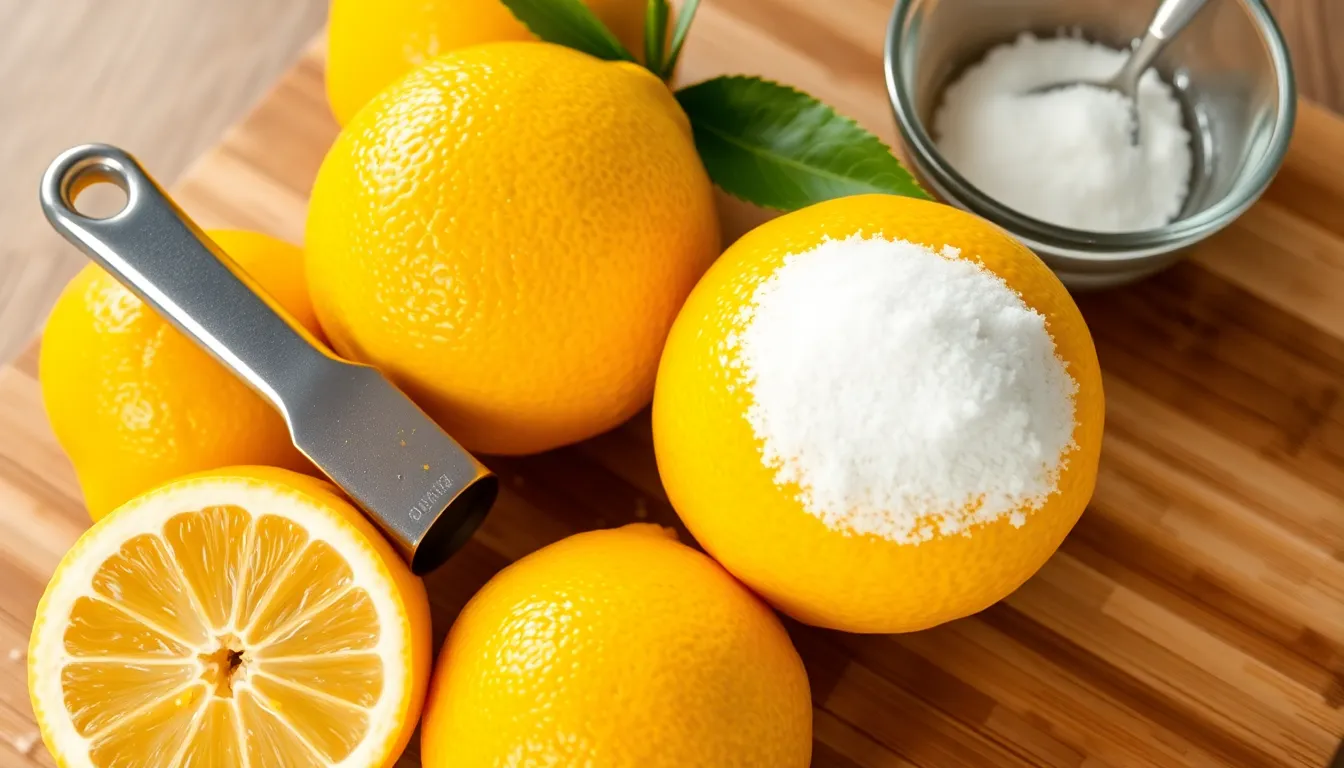
Proper preparation unlocks the full potential of Meyer lemons’ unique flavor profile and ensures maximum yield from these precious citrus gems. We’ll walk you through proven techniques that preserve their delicate balance of sweetness and floral notes.
Zesting Techniques
We recommend using a zester or fine grater to carefully remove only the colorful outer skin of Meyer lemons while avoiding the bitter white pith underneath. The thin skin of Meyer lemons makes zesting easier than traditional lemons but requires a gentle touch to prevent gouging into the fruit.
Rubbing the fresh zest directly into granulated sugar releases the essential oils and creates an aromatic base for Meyer lemon curd and other desserts. This technique intensifies the citrus flavor and distributes the oils evenly throughout your recipes. We find that one Meyer lemon typically yields about 1 tablespoon of zest due to their generous surface area.
Fresh zest should be used immediately for maximum impact or can be frozen in small portions for future use in baking projects.
Juicing Methods
Heavy Meyer lemons contain the most juice so we always select fruits that feel substantial in our hands when shopping. Rolling the lemon on a hard surface while applying gentle pressure helps break down the internal membranes and increases juice yield before cutting.
Hand squeezing works well for small quantities but we prefer using a manual or electric juicer for larger batches to ensure consistent extraction. The thin skin of Meyer lemons makes them easier to juice than thick-skinned varieties and typically produces more liquid per fruit.
Straining the fresh juice through a fine mesh removes seeds and pulp for smooth sauces and beverages. Room temperature lemons yield more juice than cold ones so we recommend bringing refrigerated fruit to room temperature before juicing.
Preserving Meyer Lemons
Meyer lemon marmalade extends the season by transforming 2.5 pounds of fresh lemons into a spreadable preserve through cooking with water and sugar. We chop the entire fruit including the peel to capture the full spectrum of flavors and natural pectin for proper gel formation.
Creating Meyer lemon curd involves gently cooking fresh juice with eggs sugar and butter until the mixture thickens into a silky spread. This preserve captures the fruit’s essence in a versatile form that works as a filling topping or standalone treat.
Freezing juice or zest in ice cube trays or small containers preserves Meyer lemons for year-round use in recipes. We portion the juice into standard measurements like tablespoons or quarter cups for easy recipe integration later.
Proper storage in glass jars maintains the bright flavors and beautiful golden color of homemade Meyer lemon preserves for several months in the refrigerator.
Storage and Make-Ahead Tips
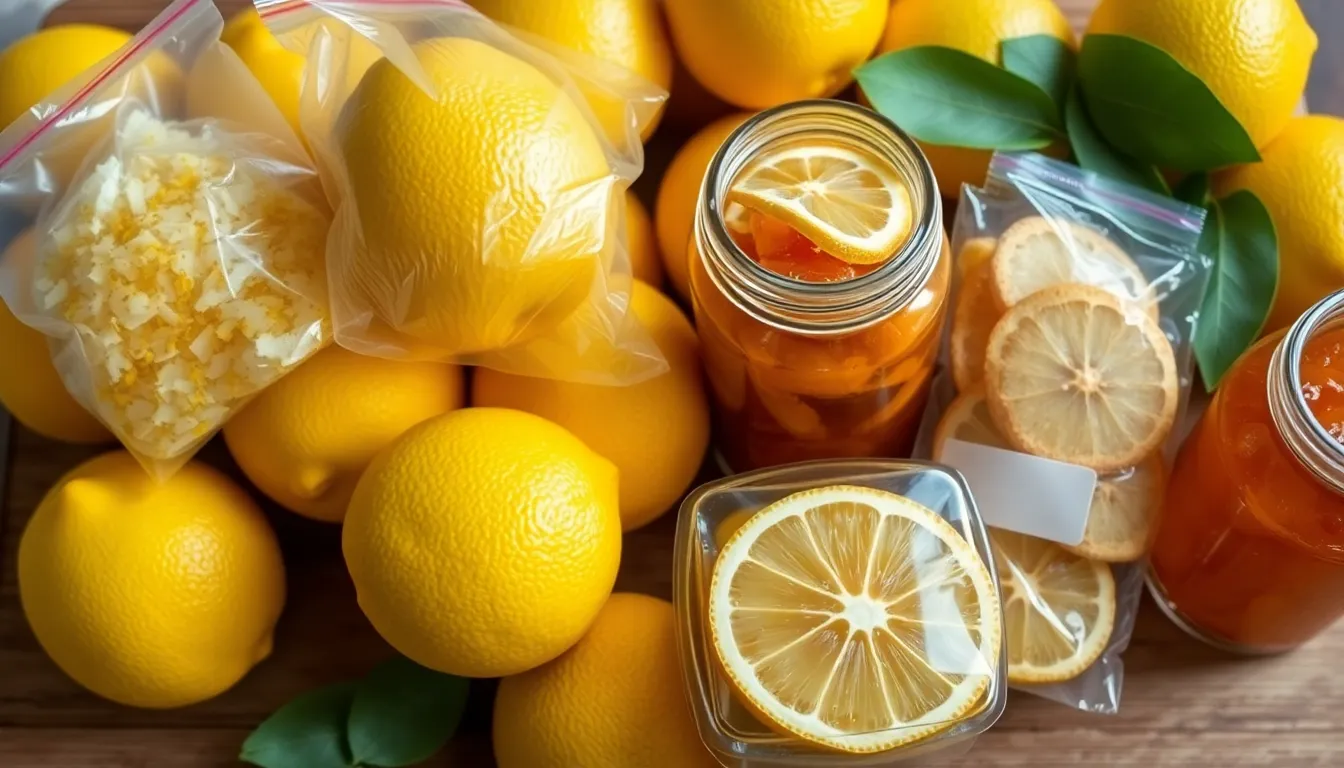
Proper storage techniques ensure we maximize the shelf life and flavor of our Meyer lemons while enabling convenient meal preparation. Fresh Meyer lemons maintain optimal quality when stored at room temperature for approximately one week or refrigerated for up to two weeks. We recommend selecting the storage method based on our intended usage timeline.
Extending Meyer Lemon Shelf Life
Freezing zest in plastic bags provides us with instant access to citrus flavor throughout the year. We can portion the zest into tablespoon measurements before freezing to streamline future recipe preparation. Meyer lemon ice cubes offer another convenient preservation method that maintains fresh juice for beverages and cooking applications.
Creating dehydrated Meyer lemon slices extends their usability significantly. We slice the lemons thinly and dry them completely before storing in airtight containers for up to one year. These dried slices enhance teas and soups with concentrated citrus essence.
Make-Ahead Preservation Methods
Preserved Meyer lemons represent one of our most versatile make-ahead options. We slice the lemons and remove all seeds before soaking them in kosher salt. The curing process requires five days at room temperature after packing them tightly in jars. Once cured we store them in the refrigerator with olive oil for up to twelve months.
| Storage Method | Duration | Best For |
|---|---|---|
| Room Temperature | 1 week | Immediate use |
| Refrigerated | 2 weeks | Extended freshness |
| Frozen Zest | 6 months | Baking and cooking |
| Ice Cubes | 3 months | Beverages |
| Dehydrated Slices | 1 year | Teas and garnishes |
| Preserved in Salt | 1 year | Savory dishes |
Meyer lemon marmalade and chutney provide excellent long-term storage answers that concentrate the fruit’s unique flavors. We prepare these preserves during peak season to enjoy Meyer lemon brightness year-round. The marmalade process involves chopping lemons and cooking them with sugar and water before proper canning techniques ensure safe storage.
Strawberry Meyer lemon marmalade combines seasonal fruits for a distinctive preserve that captures spring flavors. We coordinate the preparation with both fruits’ peak seasons to achieve optimal taste and texture. These preserved options eliminate waste while providing us with gourmet ingredients for future culinary adventures.
Substitution Guide for Meyer Lemons
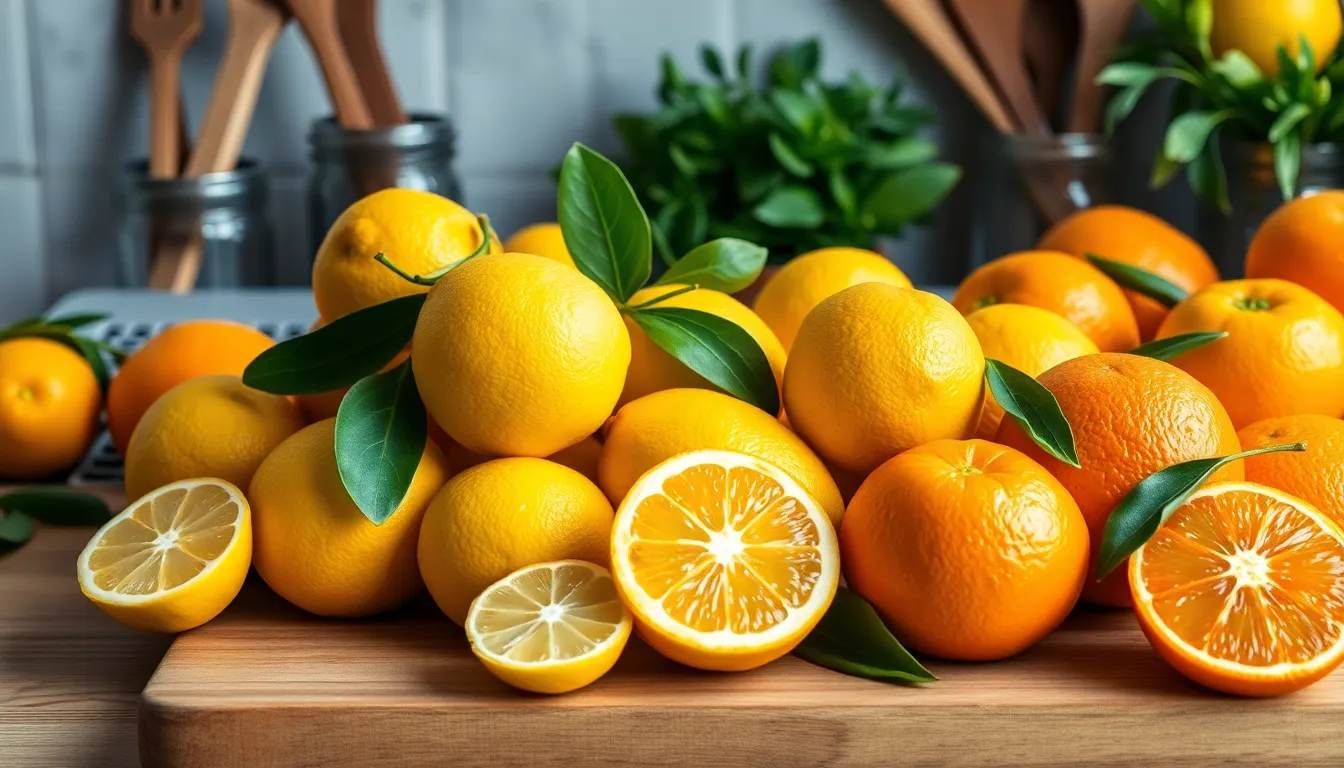
Regular lemons serve as the most common substitute when Meyer lemons aren’t available in your local market. We recommend using three-quarters the amount of regular lemon juice and adding one tablespoon of fresh orange juice per lemon to mimic the sweeter profile. This combination helps balance the increased acidity that traditional Eureka lemons bring to recipes.
Adjusting sugar levels becomes essential when working with regular lemons as substitutes. We suggest increasing granulated sugar by 2-3 tablespoons in dessert recipes to compensate for the higher acid content. Regular lemons contain 25% more acidity than Meyer lemons, making this adjustment crucial for maintaining proper flavor balance.
Combining citrus fruits creates another effective substitution method. We blend equal parts regular lemon juice with fresh mandarin or orange juice to approximate Meyer lemons’ unique hybrid characteristics. This mixture delivers the bright citrus notes while incorporating the subtle sweetness that makes Meyer lemons special.
Lime juice mixed with orange juice offers an alternative approach for certain recipes. We use two parts lime juice to one part orange juice when Meyer lemons aren’t accessible. This combination works particularly well in marinades and savory applications where the floral notes matter less than the citrus brightness.
| Substitution Ratio | Meyer Lemon Amount | Substitute Combination | Sugar Adjustment |
|---|---|---|---|
| 1:1 | 1 Meyer lemon | 3/4 regular lemon + 1 tbsp orange juice | +2-3 tbsp sugar |
| 1:1 | 1/4 cup Meyer juice | 3 tbsp regular lemon + 1 tbsp mandarin | +1-2 tbsp sugar |
| 1:1 | 1 Meyer lemon zest | 3/4 regular lemon zest + 1/4 orange zest | No adjustment |
Zest substitutions require careful consideration since Meyer lemon peels are thinner and more aromatic. We recommend using three-quarters the amount of regular lemon zest combined with one-quarter orange zest to replicate the complex flavor profile. Regular lemon zest alone can overpower delicate desserts with its more intense bitter compounds.
Fresh yuzu juice provides an excellent substitute in Asian-inspired recipes where Meyer lemons appear. We use yuzu in equal proportions to Meyer lemon juice since both fruits share similar sweetness levels and floral characteristics. This substitution works exceptionally well in dressings and light sauces.
Bottled Meyer lemon juice can replace fresh Meyer lemons when necessary, though we always prefer fresh fruit for optimal flavor. We use bottled juice in equal amounts but recommend adding fresh orange zest to restore some of the aromatic qualities lost in processing. Fresh juice provides 30% more natural sugars compared to bottled alternatives.
Temperature adjustments become important when using substitute citrus fruits in baking applications. We reduce oven temperatures by 25 degrees when using regular lemons instead of Meyer lemons in custards and curds. The higher acidity in regular lemons can cause proteins to set more quickly, potentially leading to curdling.
Seasonal Cooking with Meyer Lemons
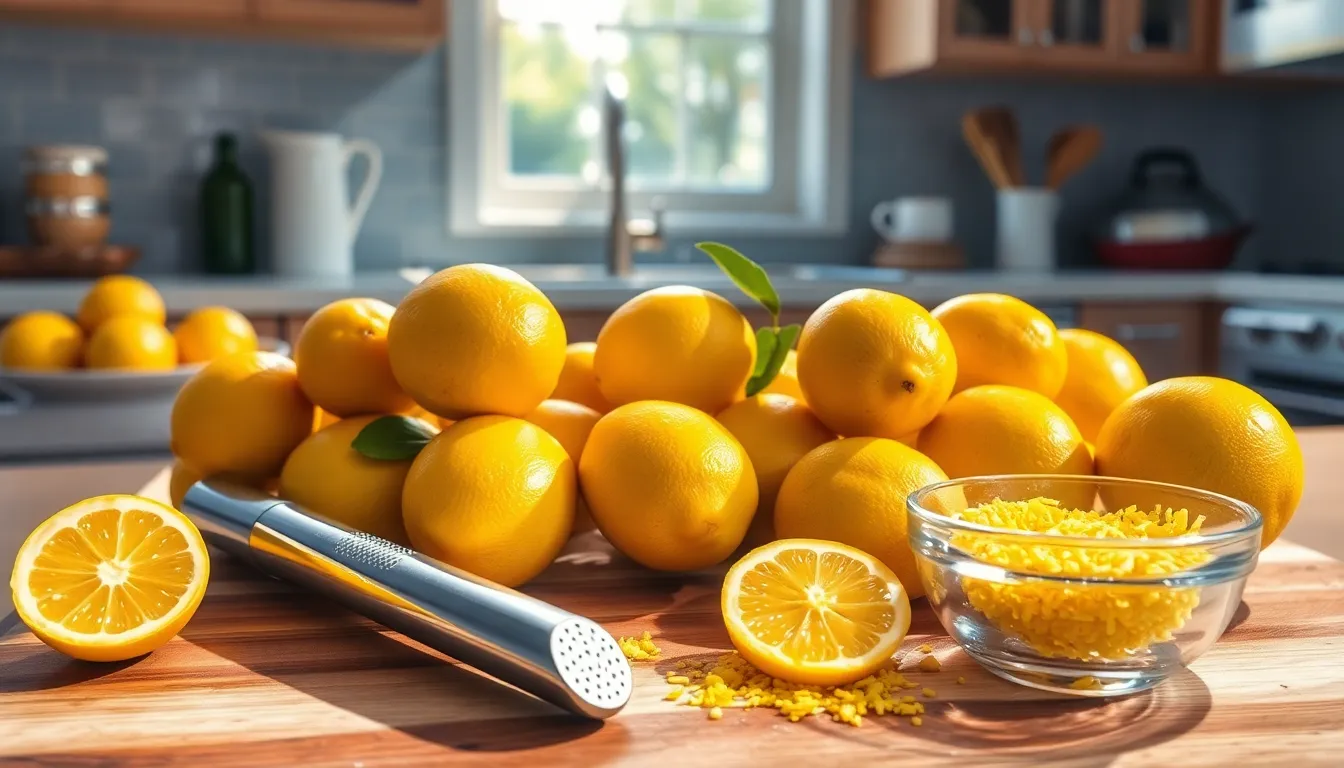
Winter brings us the perfect opportunity to embrace Meyer lemon season, which spans from December to early April. These golden treasures offer their peak flavor during the coldest months when we crave bright, aromatic dishes to brighten our tables.
We love taking advantage of Meyer lemons’ natural sweetness during their prime season. Their cross between regular lemons and mandarin oranges creates a unique flavor profile that transforms winter cooking from heavy comfort foods to lighter, more vibrant meals.
Planning Your Meyer Lemon Menu
Our seasonal approach begins with understanding Meyer lemons’ versatility across different meal categories. We recommend incorporating them into multiple courses to maximize their impact during their short season.
Sweet Applications work beautifully for winter entertaining. Meyer lemon pie becomes our go-to dessert for holiday gatherings, while Meyer lemon crinkle cookies provide the perfect balance of sweet and tangy flavors. We find that Meyer lemon bundt cake offers moisture and brightness that cuts through rich winter meals.
Beverage Pairings help us extend Meyer lemon season throughout our menus. A grapefruit and Meyer lemon mocktail provides refreshing contrast to heavier winter fare. We often serve this alongside our Meyer lemon and olive oil cake for a cohesive citrus experience.
Maximizing Seasonal Value
Smart shopping during Meyer lemon season allows us to preserve their flavors year-round. We source them from major grocery stores, farmer’s markets, and Costco when they’re most abundant and affordable.
Juice Preservation becomes essential for extending their season. We extract fresh juice for immediate use in cocktails and lemonades, then freeze additional portions in ice cube trays for future recipes.
Zest Applications offer incredible versatility during peak season. We candy Meyer lemon zest for dessert garnishes and pulse fresh zest with sugar to create infused lemon sugar perfect for winter baking projects.
Roasted Preparations transform Meyer lemons into condiments that elevate our winter cooking. Roasted Meyer lemons become incredible accompaniments to roasted chicken or additions to hearty chicken soups that warm us through the cold months.
Seasonal Recipe Rotation
| Recipe Type | Best Season Months | Flavor Profile | Uses |
|---|---|---|---|
| Meyer Lemon Pie | December-February | Sweet, aromatic | Holiday desserts |
| Crinkle Cookies | January-March | Tangy, sweet | Winter entertaining |
| Bundt Cake | December-April | Moist, citrusy | Weekend baking |
| Roasted Lemons | Peak winter | Concentrated, syrupy | Condiments |
Our seasonal cooking strategy focuses on batch preparation during peak availability. We make large quantities of Meyer lemon curd and marmalade when the fruit is at its best, then use these preserves throughout the year in various applications.
The reduced acidity of Meyer lemons compared to traditional lemons means we can use them more liberally in our seasonal cooking without overwhelming dishes. This quality makes them perfect for the rich, comforting foods we prepare during winter months.
Conclusion
We’ve explored the remarkable versatility of Meyer lemons and their ability to transform both simple weeknight dinners and special occasion treats. These golden treasures offer endless possibilities for creative cooks who want to add brightness without overwhelming tartness.
Whether you’re making your first batch of Meyer lemon bars or experimenting with savory applications we hope you’ll embrace the seasonal nature of these special citrus fruits. Their limited availability makes each recipe more precious and encourages us to make the most of their peak winter season.
Start with one recipe that appeals to you most and let the natural sweetness and floral notes guide your culinary adventures. You’ll quickly discover why Meyer lemons have earned such a devoted following among home cooks and professional chefs alike.
Frequently Asked Questions
What makes Meyer lemons different from regular lemons?
Meyer lemons are sweeter and less acidic than regular lemons due to their hybrid nature – they’re a cross between a lemon and a mandarin orange. They contain 30% more natural sugars, have 25% lower acidity, and feature a more complex flavor profile with floral undertones and subtle mandarin sweetness.
When is the best time to buy Meyer lemons?
Meyer lemons are at their peak from December through May, with the highest quality during winter months (December to early April). This is when their flavor is most balanced and their sweetness is at its maximum.
Can I substitute regular lemons for Meyer lemons in recipes?
Yes, but you’ll need to adjust the recipe. Mix regular lemon juice with orange or mandarin juice to approximate Meyer lemon’s sweetness. You may also need to reduce sugar content since Meyer lemons are naturally sweeter than regular lemons.
How should I store Meyer lemons?
Store Meyer lemons at room temperature for about one week or refrigerate for up to two weeks. For longer storage, freeze the zest in plastic bags or preserve the juice. You can also make marmalade or cure them in salt for year-round use.
What equipment do I need for cooking with Meyer lemons?
Essential equipment includes a food processor for zesting, a fine mesh strainer for removing seeds, a thermometer for temperature control when making curds, a heavy-bottomed saucepan for even heating, and glass jars for storing preserves and maintaining flavor.
How do I get the most juice from Meyer lemons?
Choose heavy lemons as they contain more juice due to their thin skin. Roll the lemons on a counter before cutting to break down internal membranes. Meyer lemons naturally yield more juice than regular lemons because of their thinner skin and higher juice content.
What are the best Meyer lemon recipes for beginners?
Start with simple recipes like Meyer lemon bars, fresh Meyer lemonade, or Meyer lemon vinaigrette. These recipes showcase the fruit’s natural sweetness and balanced acidity while being easy to prepare and requiring minimal specialized techniques.
Can I use Meyer lemons in savory dishes?
Absolutely! Meyer lemons work excellently in savory applications like roasted chicken marinades, pasta sauces, and salad dressings. Their lower acidity and floral notes enhance dishes without overpowering them, making them perfect for seafood and poultry preparations.

